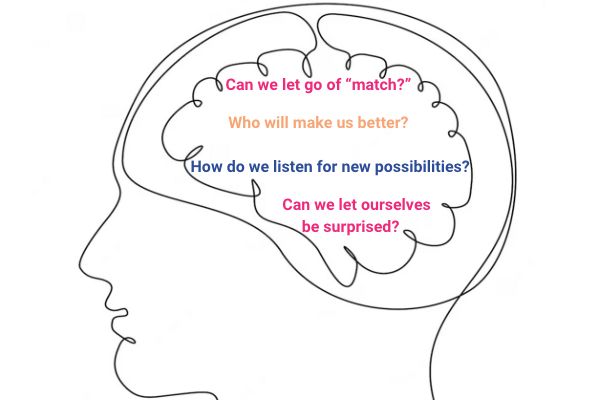In this piece, Tom Wolf discusses the need to re-think the interview process by leaving behind the search for a “good match” and instead emphasizing the search for a good partner.
By Thomas Wolf
Interviews are gateways. They can throw open or slam shut jobs, internships, or grants. As human interactions, interviews are susceptible to all the assumptions and biases we bring as people. As long-established procedures, they come trailing many established–and often unexamined–ways of working. Borrowing from the newest edition of his book, Managing a Nonprofit Organization (40th anniversary edition, New York: Simon & Schuster, 2022), Tom Wolf discusses the need to re-think the interview process by leaving behind the search for a “good match” and instead emphasizing the search for a good partner.
Consider This Case
Joan* is the Executive Director of a large community arts organization in a major mid-western city. For the first time, her staff is now majority people of color, more than 60% female-identified (including two transgender members), with an average age of 37. Joan is African-American and speaks regularly at conferences about her recruiting, hiring, and on-boarding practices.

Currently, Joan is hiring a new senior staff person – a Field Supervisor for her team of 15 community-based field staff. Though she will ultimately take responsibility for the final decision for any direct report, Joan is inviting her three top deputies and the Chair of her Board Program Committee to assist in interviews. These four individuals are all young and well-educated, identify as female, and all are women that Joan herself had recruited. Two are white, one is Black, and the fourth is Latina. Two have master’s degrees, another has a Ph.D. from recognized institutions of higher education. They are a tight and well-oiled team, often finishing each other sentences in meetings. Joan and her team are not just colleagues – they are friends.
The three final candidates are all individuals of color. Candidate A, a 28 year old woman, recently received her master’s degree from the same Ivy League school that Joan herself attended. While Candidate A has less experience in the supervisory area, she has five years of field experience. Candidate B – age 37 – is also a woman, has a Ph.D., and has published several articles that reflect her understanding of issues in the field. However, except for internship work, Candidate B has spent very little time on the ground. The third candidate, Candidate C, is a 57-year-old gay man who eventually received his GED from a local high school and spent two years at a community college. Unlike Candidates A and B, Candidate C has worked both as a coordinator and a supervisor in previous roles. While the job announcement mentioned the ideal education level for candidates, it was clear that this was a “desired” attribute and that field experience also mattered.
Joan and her colleagues set up the interview to level the playing field. Each candidate received the same packet of materials in advance about the organization, which also included questions that all candidates would be asked, although follow-up questions would be based on their respective responses. In addition, all three candidates were given a description of a challenging “situation” and were instructed to come prepared to discuss how they would handle it. All interviews took place at the same location and met with the same interview team.
In their interviews, Candidates A and B shine. It is as if they are already part of the senior staff, so articulate are their answers and so sophisticated their questions. Even their humor seems ready-made for the group. Candidate C is less comfortable. His speech is more halting. His vocabulary is less expansive. His conceptual understanding of the field’s larger questions doesn’t appear to measure up to those of his competitors. Yet, more than the other candidates, his response to the “situation” and his references make it clear that he will be able to relate directly to clients, given his own experience living and working in under-resourced communities.
In reviewing these three candidates, it is clear that Candidates A and B make the hiring team very comfortable. Both would fit in beautifully. A special bonus is Candidate B’s writing ability – if hired, she could help the fundraising staff write compelling grant proposals. Candidate A, though less experienced, offers rich potential. “How wonderful that we can get someone at the beginning of her career and really shape her understanding of the work,” says one of the interviewers, remembering her own entry into the field at a young age.
The team is less comfortable with Candidate C, noting that he raised questions about whether his field experience would lead to an equivalent level of pay as people with advanced degrees. Though there is no question that he could do the job, there is an immediate concern about how well he would fit in. His track record is impeccable, but the comments of the interview team are revealing:

“I know I am not supposed to say this, but he is almost the same age as my parents. What about his energy level and how long will he stay with us?”
“His major question was about pay. I would have hoped he would be more concerned about the job.”
“Will he be able to speak wisely and articulately in staff or board meetings? What about with funders? I don’t think it is a good fit.”
Joan shifted the conversation. “Let’s think about these questions:
- What are our biases with respect to this hiring situation and are they affecting how we view the three candidates?
- What are our obligations to our staff and constituents? How well does each of these candidates meet those obligations?
- What are our values as an organization and how will each of these candidates be a partner in carrying out these values?”
Re-tooling Interviews: From “Fit” to “Contribution”
With these questions, Joan took the process from a focus on “fit” to examining how each of these candidates might make a unique contribution to the work they want to accomplish.
Certainly, an important factor in hiring is an organization’s culture and how an individual will fit in.
But putting fit first cuts off any discussion about who will further the work. Sometimes, an organization’s culture is unhealthy, and new hires can help improve it. Think of an organization where people spend so much time socializing that they get little work done. Or another organization where the sense of competition is so great that people do not work together. Staff vacancies may be opportunities to work at changing such pathologies. Focusing on fit could limit an organization’s ability to provide opportunities to a wide range of qualified candidates, and precludes diversifying homogenous workplaces that may need a richer pool of backgrounds and perspectives.

But perhaps most concerning is how an emphasis on fit can mask personal biases and lead to replication: highly educated women hiring more highly educated women (or white male writer teams hiring more white male authors). Some aspects of comfort/discomfort with a candidate are valid. For example, if a new hire cannot adapt to a consultative culture where staff are interested in and respectful of what others think, then their presence could disrupt effective, collaborative workflows. But that is quite different from penalizing Candidate C for asking candid questions about pay equity, or being more focused on the complexities of on-the-ground scenarios rather than surrounding policy debates. Someone may be less compatible with this tight, smooth-running environment, but their greatest benefit to the organization may be exactly that they don’t fit. These differences in perspectives and experience may even help earn the trust and respect of constituents who otherwise might not “click” with other staff.
If interviews are going to be occasions for amplifying, rather than foreclosing, opportunities, it is vital to recognize that basic forms of equity are important: everyone deserves common criteria, setting, time, interviewers, and questions. But those basics are far from enough:
- Every interview is an opportunity for an organization to be clear about its values and its willingness to act on those values. If Joan’s organization values “respect for one another” and “a willingness to request and give feedback openly,” then they shouldn’t dismiss Candidate C’s question about pay equity as inappropriate.
- Interviews and decisions have to be less about fit and more about unique contributions. Which of the candidates brings knowledge and experience that the organization needs?
In the end, Candidate C was hired as Field Coordinator. Despite concerns about compatibility during the interviews, Candidate C quickly found himself growing familiar and comfortable with senior staff and board members, and his quality of work continues to exceed expectations. By turning their attention from “fit” to “contribution,” Joan and her team amplified opportunities for candidates, for themselves, and for their organization’s future.
* Note: The organization and the individuals described above are anonymized, but based on actual examples from WolfBrown’s consulting practice.

This post is a part of the Re-Tooling the Trade focus of our Amplifying Creative Opportunities newsletter.
Read more of the second issue of our Amplifying Creative Opportunities newsletter.


